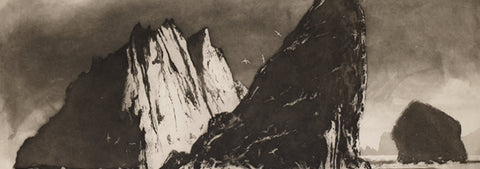Drawn 2017 Invited Artist Norman Ackroyd

Norman Ackroyd: Invited Artist for our 2017 Drawn exhibition
Helen Cobby
Drawn is our biennial open submission drawing exhibition, which aims to explore the boundaries of drawing and celebrate it as both an autonomous discipline and an interdisciplinary tool. Our Invited Artist for this this years’ Drawn is Norman Ackroyd RA. His work is exhibited alongside both emerging and other established artists from the UK and beyond who either draw or explore the concept of drawing. Ackroyd last exhibited with us in 2014 for the exhibition The Power of the Sea, so we are delighted that more of his work has returned to the gallery in a different context, allowing visitors to gain further insight into his practice.
He is an appropriate Invited Artist for Drawn because drawing has always been central to his work, whether he is outside recording natural scenes in his sketchbooks or working in print. His etching technique requires careful mark-making on copper plates. He also is a well-loved landscapist, immersing himself – and by extension the viewer – in creative details and recorded memories of the natural world. Interestingly, many of the selected artists for this years’ Drawn depict aspects of nature and reference it as a core inspiration for their work.
Ackroyd studied at Leeds College of Art from 1956 to 1961, and subsequently at the Royal College of Art, London from 1961 to 1964. He has had many solo exhibitions, both in Britain and internationally, and has received several public mural commissions. He was elected a Royal Academician in 1988, appointed Professor of Etching at the University of the Arts in 1994, made Senior Fellow of the Royal College of Art in 2000 and awarded a C. B. E. for Services to Engraving and Printing in 2007. His work is in numerous private and public collections worldwide including Art Institute of Chicago; Arts Council Collection, London; British Museum, London; Museum of Modern Art, New York; National Gallery of Canada; Queensland Art Gallery; Rijksmuseum, Amsterdam; Tate Gallery, London; and The Royal Collection, Windsor Castle. The fact that some of his work is in The Royal Collection enhances the link between his work in Drawn and the concurrent RWA exhibition of historic drawings on loan from The Royal Collection, entitled Lines in a Landscape: Drawings from The Royal Collection. For more information about this exhibition, please see here.
Ackroyd currently lives and works in Bermondsey, London, in the same studio he has occupied for over thirty years. Perhaps surprisingly, it is from here that he creates his highly atmospheric prints portraying the sublime beauty of rugged mountains and jagged coastlines. His printing press dates back to the 1900s. It was built by Welsch, the same firm that Whistler used for his copper plates, and was later refurbished by the artist Merlyn Evans. Ackroyd says that it is “probably the best printing press in Europe and it’s an absolute delight to be able to work with it”.
There are four etchings by Ackroyd in Drawn, each depicting coastal landscapes of St Kilda, the remotest part of the British Isles, located off the north-west coast of Scotland. The archipelago of St Kilda includes many of the most spectacular sea cliffs in the British Isles; Stac lee and Stac an Armin are the tallest sea stacks in Britain. The extensive group of islands making up St Kilda became one of Scotland’s six World Heritage Sites in 1986 and is one of the few in the world to hold joint status for its natural and cultural qualities. Ackroyd’s etchings of this place are part of his three-year project “attempting to understand the necklace of rocks and skerries that stretch North East from St Kilda for 400 miles via Flannan, Sula, North Rona, Foula and Papa Stour to the Rumblings, Muckle Flugga and finally to Out Stack”.
In each of these etchings, capturing the quality and impression of natural light appears important to the artist. Purposeful shards of light help to draw the viewer’s eye into the composition, as well as to create connections and balance between the sky, land and sea, and to encourage focus on the textures and forms of these natural elements. This use of light also creates intense contrasts between light and dark areas, heightening the atmospheric drama of St Kilda as felt by the artist. This is reminiscent of JMW Turner’s handling of light in his own work; for both artists it is a technique, compositional device and subject matter in one. Ackroyd’s practice also has other affinities with that of Turner’s: They share a similar experimental approach to print-making; they both capture extreme qualities of nature (for example, the beautiful sublime and the dangerous elements of the natural world); and are drawn to travelling to and depicting remote and hostile locations.